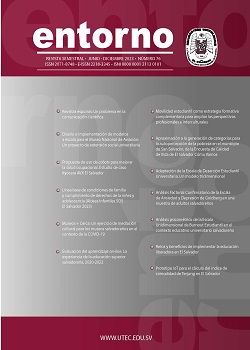Baseline on Family Conditions and the Compliance of Children and Adolescent Rights (Aldeas Infantiles SOS El Salvador 2023—SOS Children´s Villages El Salvador 2023)
Published 2024-06-18
Keywords
- Adoptive homes - El Salvador - Child welfare,
- Community homes for the youth,
- Children´s rights,
- Social support,
- Social inequality
Copyright (c) 2023 Universidad Tecnológica de El Salvador

This work is licensed under a Creative Commons Attribution-NonCommercial-ShareAlike 4.0 International License.
How to Cite
Abstract
The following research details the results of a baseline study for the family strengthening and prevention of abandonment program of SOS Children’s Villages El Salvador, in the context of the five locations within the country. For this, the face-to-ace survey technique was used via a questionnaire administered to a total sample of 175 families distributed in the following departments: San Vicente and La Libertad (central region), San Miguel (eastern region), plus Santa Ana and Sonsonate which belong to the western region. The objectives of the study are focused on the following areas: food security, access to health services, equal access to education, household means of subsistence, protection of children and adolescents, and support and participation of the household within the community. The level of vulnerability of the families represented in the baseline, beyond allowing permanent monitoring and evaluation through the institution’s own indicators, reflects a snapshot of the current situation of the individuals who were part of the sample, highlighting that there is still a long way to go to reduce these gaps of social and economic inequality to bring them to a decent level of quality of life and get them out of that complex condition. This is a typical condition of the most vulnerable groups in any society, and it requires an effort from multiple actors in both the public and private sectors, as well as the third sector (the one represented by NGOs, foundations, churches, the civilian society, and of course, the higher education institutions (HEIs)) as a vehicle to bring actions aimed at this type of population.

